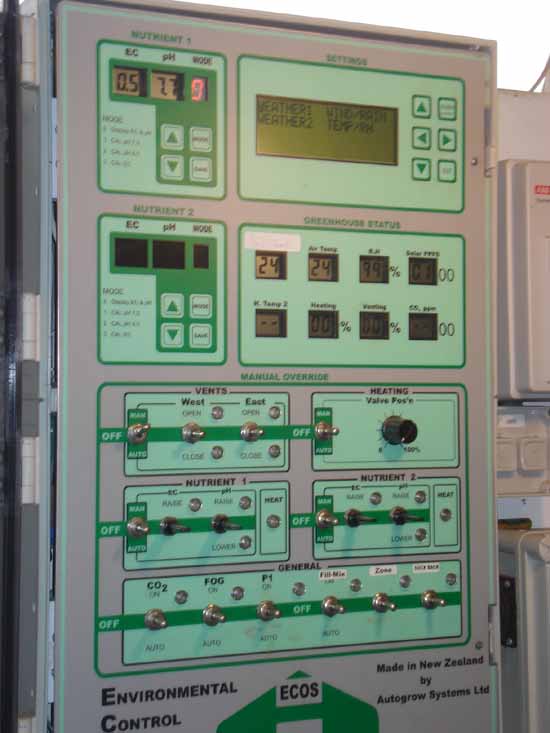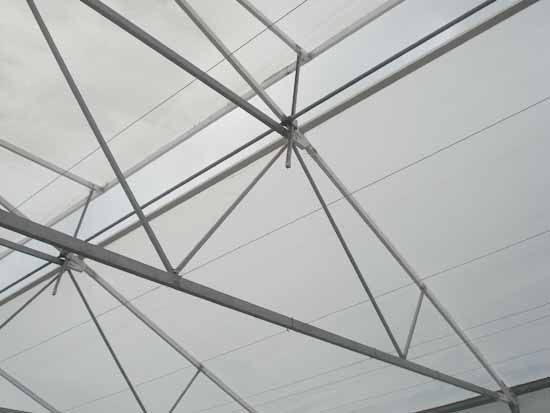GRASS FODDER BY HYDROPONICS
IN 8 DAYS.

Our 45 metre long grass growing greenhouse.
Grass fodder is used as an animal feed and can be produced in great numbers within 8 days from seed to grass for all livestock. Various varieties of grass fodder include, but are not limited to, barley, oat grass, lucerne grass, to rye grass or whatever grass one wishes to grow in ones country.
SEEDS & NUTRIENTS:
Growing fodder you need to have seeds which can be barley, lucerne or oats. Wheat grass will grow better in a moderate or cooler shady environment - 50 to 75 degrees Fahrenheit. If it is warmer than 85-90 degrees, the grass will tend to wilt. This is also when mold begins to show. Once the seed has been soaked in water, it is then sowed in the trays spread out evenly to around 1/2". Lay the seed in trays, spray then drain them with a low nutrient mix. You can also just used buckets to sprout your seeds. In 24 hours they sprout a root, green shoots within the 2nd and 3rd day, by 7 days is nearly the finish before they slow down and are now ready to harvest.A trickle feed to soak the trays is used & collected at one end hence the trays are slightly sloped for runoff. Nutrients, are the key to growing your grass to obtain the best growth and nutritional value are can be are mixed with solutions of calcium nitrate, potassium nitrate, ammonium nitrate,iron chelate, magnesium sulfate. You can even buy a base fertilizer nutrient but this depends in the country you are in so best to seek advise from your local Agriculture or Horticulture supplier in the country you are in. The seed and the added value of the nutrients allow the seeds to mature quick hence the 8 day cycle. You can set out your trays and date them according to there start to finish which can be 7-8 days ---its that simple. pH can be controlled by using very small amounts of phosphoric acid added to the solution.

TEMPERATURE OF SEED
Temperature is very important growing seeds & will vary in every country. With temperatures outside often reaching 40?C - 50?C in the Middle East, the temperature within the unit needs to be maintained at around 24-30?C. Barley seems easiest to grow in the heat but oats is also OK as are other grasses. High levels of light are not necessary, but cool temperatures are. I recommend some shade. Since they like to be below 25 degrees and you are that hot, you should forget the shade and put a solid roof over them, insulated if possible; clear plastic sheeting, and shade cloth sides to the building.The other alternative is to use twin roof heavy plastic greenhouse sheeting to stretch over the roof
MISTING OF SEED BEDS
Misting by using fine droplets is important also and their are various ways one can mist to get the right affect. Its really down to experimenting. The other way is to have a very small micro trickle of water that soaks the trays very slowly just enough to allow the seeds to grow. Some people use a fan mist to spray over the seed beds another good alternative. Many of the production systems utilize very fine climatic control in an effort to limit the amount of mould spores that can germinate. Again it is experimenting eg with micro-misting systems but again this will depend in the country you are setting up in.
SEED BEDS & TRAYS
Trays should be plastic preferred black for easy cleaning and with either slight indents or borders to allow the flow of water down but for the seeds to stabilize.The main thing is lots of slope when the roots become thick and less when they are still sprouting. A textured ridge on the base to stop the seeds from sliding is good. The trays should drain at one end into a plastic gutter. Many people just use the lids from storage crates for small systems but we use a guttering tray that slots into the stands. Plastic manufacturers can supply these fairly easily so use a tray that is about 65x45cm, and has some ridges across them to keep the seed from moving down as said previous. Use black because it requires less cleaning & make sure there is good free running drainage in the tray. Wash seed before putting in trays & as we say a lot do not ever let your hands touch the seed - use plastic gloves. Do not disturb the seed once the rootlets emerge.You do not need a medium on the tray itself but some systems use a cellulose bio degradable paper which allows satuation of the seed bed but also stops movement although movement is rare as the slope of the trays is only enough for runoff. When ready the seed beds are just pulled out and can be fed to the livestock as a whole. The livestock eat not only the leaves, but the entire root system,which has both fibre or roughage and protein the ideal feed for growing. The work is easy, & can be a few hours a day by one person.
To give you an idea you can harvest 100 trays a day (with 800- trays in the green house so we say approx 8:1 ratio). After use, it is important to rinse all trays are washed out in a chlorine-based solution before starting the cycle again and re-sowing. If using buckets of water to sprout drain this water before laying on the trays. Again its important to look at sterilization and cleanliness throughout. Do not leave any longer in the trays and 6 days is the max due to the groth of fungus

Fully adjustable roof void with auto openers for temperature control
COST SAVINGS:
The installation of the building and complete system complete and all systems go this is what one can now save. The system itself only needs one person to run it so the cost to maintain labour is minimal. If one has an adequate water supply then you have no worries with water your main source. Closer to agents and where you live is an added plus as your delivery costs are reduced. Alternate power sources again drop the cost. Livestock are friendly and easy to manage & you get the added value of Grass all year round. Whats more your system can be automated & only needs 1-2 hours per day to look after --now hows that for livestock husbandry.
[ Beginnings ] [ Construction ] [ Nutrients ] [ Fungus & Important points ]